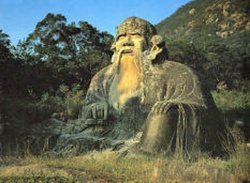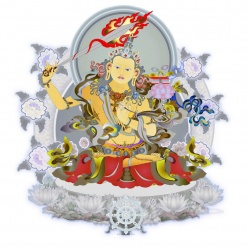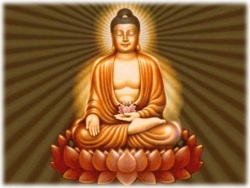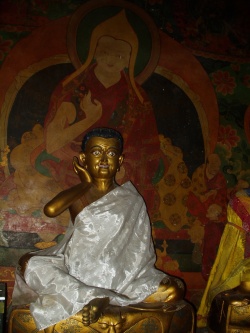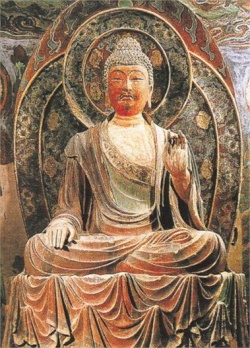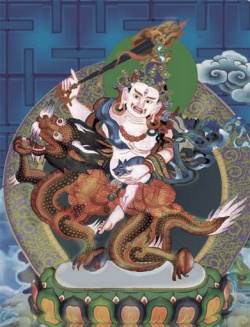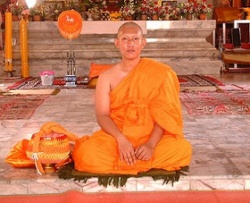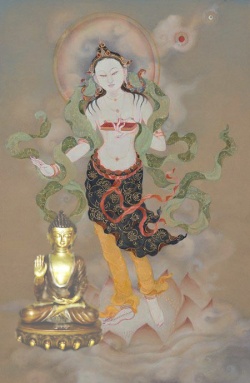What Insights Can Tiantai Buddhism Offer Higher Education? by Ven. SHI Sheng Ying
What Insights Can Tiantai Buddhism Offer Higher Education?
Ven. SHI Sheng Ying, Huafan University, Taiwan
November 2013
Abstract
Tiantai School (天台) is one the eight schools of Chinese Mahayana Buddhism. Its central doctrine is the unity of the teachings (theory) and Zhiguan meditation (止觀) (practice) (教觀並重). Equal emphasis is given to the unity and integration of both, to the extent that “theory is the practice and practice is the theory”. The Tiantai School (with its zhiguan (止觀) meditation ) was established by the lineage’s third Master Zhiyi (智顗 538-597AD) as one of the most comprehensive systems to enable practitioners to progressively work out their own enlightenment and be liberated from their own afflictions. Though we know that Buddhist teachings are universal, we need to make Buddhism relevant to the youth of today and make the practical and spiritual benefits understood to the wider community especially its applicability in the higher education setting. With such a background in mind, one of Zhiyi’s three meditation systems, the Six Wondrous Gateways Meditation (Liumiao Famen 六妙法門 [1] here after LMFM) will be explained in detail in this paper and some of its integration into our modern day society is introduced, particularly its applicability in Higher Education will be discussed. As turbulent change is more evident in the world today, there needs to be some method of calming our mind in order to cope better and still be in a holistically healthy state without adverse effects on the physical, emotional, psychological, and spiritual levels. It is believed that Tiantai Buddhist meditation can be appropriate at this time due to its “round philosophy of teaching” in that theory and practice go hand in hand. Through the interchangeability of the six methods of meditation according to the levels of the meditator, the meditation is flexible and adaptable to a variety of learners and situations.
Introduction
One of the issues highlighted by participants in the 1998 World Conference on Higher Education was “brain drain and the lack of graduates’ preparedness for the labour market.” In addition, the 2009 World Conference on Higher Education presented many other similar trends and issues raised in 1998 that we may already be aware of, but not yet resolved, such as “Internationalisation, Regionalisation and Globalisation”, “Learning Research and Innovation” particularly mentioning that “Revitalization of Higher Education” as an important tool for a renewal of learning and scholarship, some of these can be addressed through the multi-disciplinary actions from various parties. From the issues raised in both of these conferences regarding learning and graduate students, we note that the essence of these issues that face education of which we can address on an individual personal basis rather than an institution or organizational basis, for instance the revitalization of higher education in particular, the equal access and how to prepare students to be “the global citizen” to be innovative, responsive, free, and be equipped to be able to meet the accelerating demands of the 21st Century?
We hope to provide Higher Education students the Buddhist experience as an interesting, informative, important and relevant to the modern youth, and gradually move forward integrating Buddhism with higher education in an appropriate way so that the maximum benefits can be attained by all parties concerned. It is believed that with training and familiarity practice in a contemplative method, students may become more mindful, may minimize their afflictions, become well-balanced holistically and develop more creativity, and therefore can become better prepared to meet the global challenges presented to them. It is suggested that Tiantai Liumiao Famen zhiguan meditation system can fit this call.
As this work is being prepared, the central focus had been “whether Tiantai Buddhism can play a role in the Higher Education arena?” If so, how? This line of thought shapes the whole direction of this article. As human beings, we seem to be the only species to have the unique capability of our creative search for meaning and purpose in life. Our intellectual faculty is one of the most powerful endowments that we humans have, it is the most elaborate explanations for our presence on earth – thus on the one hand, all of the Buddha’s teachings seem to encapsulate the same message – the ultimate aim of the final liberation – the goal of enlightenment – to be “awakened” – to know the truth of our being, our existence, what forces work in unison to push us in a certain direction, what are the compelling causes and conditions that enable our being, the “whats”, “hows”, and the “whys” that make up our being and that which entrusts our living.
Accordingly Buddhism is not merely a theoretical work of art, but all of the Buddha’s teachings are connected with our everyday life – how to live wisely, peacefully, and harmoniously without conflict. The teachings most common to all Buddhist traditions are not speculations and assumptions but precise specific strategies on how to treat our human ills, how to communicate with our inner self and how to deal with our outer self. Tiantai Buddhism is no exception; it is an approach on how to understand our “mind and matter” make-up and how to utilize it to manifest our utmost potential for the human good.
On the other hand, from the education perspective, students in the 21st century will need to be able to understand and interpret enormous amounts of critical information at an exceedingly alarming rate in order to make optimal sound decisions which will require an assurance of their well-being and be prepared to cope with the ever changing world. As a result of the turbulence that is at play in our world, it is believed that a well-regulated maintained mind is of paramount relevance. There are three kinds of learning that are becoming increasingly important if not essential for students to succeed in work and life. Firstly, the traditional academic knowledge and technical skills. Secondly, real world applications, students will need not just knowledge but also the critical hands-on expertise to apply their learning to meet real-world challenges, the real hands-on know-how. Thirdly, broader competencies which include innovation and resourcefulness, in their utilisation of the Information, Communications and Technology (ICT) in order to work out suitable solutions for the ever-demanding environment. The most imperative competence seems to be the ability solve new problems and think critically and creatively; strong interpersonal skills necessary for inter-personal communication and global village collaborations; creativity and intellectual flexibility; self sufficiency and autonomy, including but not limited to the ability to learn new things quickly when necessary, the open-mindedness to cope and the power to accommodate the needs of different stakeholder groups.
One of the reasons why students may not be performing at their optimal capacity is because their mind is cluttered and hence not able to be productive with the greatest effectiveness as possible. The remedies that Buddhism proposed is to understand the “laws” that govern our mind and to allow the mind the clarity and space to perform its best, we must “reduce, reuse, and recycle” our mental activities in order to produce a “clean and purified mental inner environment”. A lot of current interest had been put on the external world climate; however, it appears that less attention is placed on the focus of our mind, the inner world where a lot of the misuse, damage and harm had been generated from our inner core. We have to reduce the mental clutter that blogs our intellectual clarity; we must reuse the mental resources available and revise the know-hows of our natural environment in order to be at one with our natural world to survive the calamities and live
in harmony with nature; we must be able to sort out and classify the optimal conditions that we have with the inner and outer world, we need to strike a balance among all factors in order to achieve well-being. We must work from within in order to be at one with the outer world. This equilibrium must be achieved with the union of the heart and the mind. Inner cultivation of our mind is the domain of Buddhism. It is suggested that Tiantai Buddhism with the integration of the teachings and practice can provide such a mental resource for students.
Tiantai Buddhism
Buddhism is transmitted to China since the Han Dynasty (206 BC – 220 AD), it flourished and peaked during the Tang Dynasty (618AD – 907AD), during this period, Mahayana Chinese Buddhism produced several great spiritual masters, each with its own distinctive traditions, teachings and practices. Scholars variously classified Chinese Buddhism into 7-15 Schools. One of the most prevalent systems of classification is the Eight School System. The Tiantai School is one of the Eight Schools of Chinese Mahayana Buddhism (漢傳大乘佛教八宗) which include Sanlun School (SanlunZong 三論宗)、Pureland School (JingtuZong 淨土宗)、Tiantai School (TiantaiZong天台宗)、Vijñāptimātratā School (WeishiFaxiangZong唯識法相宗)、Huayan School (HuayanZong華嚴宗)、Vinaya School (LuZong律宗)、Chan (Jp.Zen) School (ChanZong禪宗) and Vajrayana Esoteric School (MiZong密宗).
Tiantai School is an inclusive system which stresses on the “round” (yuan圓) philosophy – the unity of Doctrine and Practice (Jiaoguan Heyi教觀合一). The Mahayana teachings often speaks of the expedient means of the bodhisattva path, which means that the method of teaching will vary according to the student’s ability (Genxing根性), can be gauged at various different levels and regardless of the various amounts of practice, it will still lead to some benefits. What is unique in Tiantai, is its philosophy of “a single instant of thought three thousand realms” (一念三千), all the three thousand worlds in a single mind moment This is particularly useful because what it means is that with regular practice maintained, as long as the student is empowered and motivated to step forward, then any state they wish to attain is achievable. Some of the positive psychology suggested that students set the goal they want to achieve and hence their motivation will lead them to establish strategies relevant for their task. Inclusiveness means that students can be accepting of others’ differences and be empathetic towards others with an understanding of the multiple dimensions and discrepancies expected within groups and cross-cultural communications, and thus with tolerance generated, individuals and groups can foster a harmonious setting and be respectful with each other. This also embraces the interconnection between heart (emotional self) and the mind (intellectual self). The holistic self-incorporates several facets including at least but not limited to physiological, psychological, emotional, and spiritual.
Five Periods and the Eight Teachings
Before introducing the Tiantai meditation system, a brief background is provided about Tiantai Teachings Classification System. The Tiantai Master Zhiyi had grouped all the Buddha’s teachings at that time according to the content - the Eight Doctrines and in a chronological order into the Five Periods. The Five Periods and the Eight Doctrines (Wushi Bajiao五時八教). The first period was the Avataṁsaka Period (HuayanShi華嚴時), the Buddha taught the Avataṁsaka Sūtra (華嚴經 – The Flower Garland Sutra) to bodhisattvas and Brahmans twenty-one days after his enlightenment. The second period was Ahan Period (AhanShi阿含時), the Buddha taught the four noble truths as recorded in the Āgamas. The third period was the Vaipulya Period (FangdengShi方等時), the Buddha taught the path of the bodhisattva and compassion in the early Mahāyāna sūtras. The fourth period was the Prajnāpāramitā Period (BoreShi般若時), in this period the Buddha taught that all things are mere designations only, sunyata-the nature of all things is emptiness, there is no permanent dharma, even Buddhist terms like the nirvāna (Niepan涅槃) and the Buddha are mere concepts only. The final period was the Saddharmapuṇḍarīka Mahāparinirvāna Period (Fahua NiepanShi法華涅槃時), the teachings in this period are about expedient means (upāya方便法) in the Lotus Sūtra and Buddha-nature teaching in the Mahāparinirvāna-sūtra. Note that these five periods are mainly focused on each of the primary teachings mentioned; it does not mean that each period does not include the other teachings.
The Eight Teachings that Zhiyi proposed included two categories of four each. One group of four was in terms of the teaching method, the other group of four was in terms of the teaching content.
The four types of teachings used to cater for the different types of learners with different propensities. The first group of four, the four Teachings of Conversion (Huafa Sijiao化法四教), according to the levels of the learners, the content of the Buddha’s teachings can be classified into four main types:
- 1. The Storehouse Teaching (Zangjiao 藏教)
- 2. The Common (All-Encompassing, Pervasive) Teaching (Tongjiao 通教)
- 3. The Separate (Specific) Teaching (Biejiao 別教)
- 4. The Round (Perfect) Teaching (Yuanjiao 圓教)
The second group of four teachings, the four Methods of Conversion (Huayi Sijiao化儀四教)
Knowing the different capabilities of the learners, the Buddha utilizes different methods to give his teachings.
- 1. The Sudden Teaching (Dunjiao 頓教) – learners do not need much explanation, and can immediately understand the significance and start the practice.
- 2. The Gradual Teaching (Jianjiao 漸教) – learners may need a step by step process in order to understand the teaching.
- 3. The Secret Indeterminate Teaching (Mimijiao 秘密教) – learners may need some hidden method of metaphoric examples.
- 4. The Express Indeterminate Teaching (Budingjiao 不定教) – learners’ abilities vary according to different learning tasks and may not be of the same type when facing different situations.
With the first group of four types of the contents of the teachings of conversion, in the Mahayana view, the Storehouse Teachings (Zangjiao 藏教) would include the teachings like the Four Noble Truths, the Eightfold Noble Path, for people following the Śrāvaka vehicle (hearers Shengwen 聲聞)– the main teaching in this period emphasized the understanding of the truths of the Noble Ones, suffering (or it could be a state of dis-satisfaction or unhappiness, stress, etc.), the cause of suffering, the extinction of suffering, and that there is a path to this suffering. The aim is to set them on their own liberation, and cultivation is for the detachment of the delusions in order to attain the state of liberation.
The Common (All-Encompassing, Pervasive) Teaching (Tongjiao 通教) this type of teaching would include the twelve-link origination condition – particularly for the learners with medium faculties, the pratyekabuddha practitioners (Yuanjue 緣覺). The teachings in this period may not specifically be targeted at the Śrāvakas, but rather this teaching could be a thoroughfare as their own personal enlightenment and may follow through to the Bodhisattva stage.
The third type of teaching, the Separate Teaching (Biejiao 別教) would be on the six paramitas specially for practitioners with sharp faculties, they set on not only their own liberation but also the liberation of all beings, the attainment of a complete self and others’ enlightenment, this is the path of the bodhisattvas.
The fourth type of teaching according to Zhiyi was the Round (Perfect) Teaching (Yuanjiao 圓教) was for practitioners with the highest faculties, who learn at the fastest pace with great understanding and quick realization for the liberation of all beings. These four types of teachings imply that as education facilitators, students’ requirements need to be accommodated. Their interests need to be catered for, whatever their capacity and level, then the teaching need to be gauged at the respective level. The second group of classification, of four types of teachings are the methods of teaching which included the Sudden Teaching (Dunjiao 頓教), this type of teaching facilitates immediate realization in the practitioners. On the other hand, the second method is the Gradual Teaching (Jianjiao 漸教), this type of teaching is a step by step process, upon constant practice and feedback, then the learner can be able to gain the stated benefits. The third type of method is the Secret Indeterminate Teaching (Mimijiao 秘密教), this is more the esoteric sort of teachings. The final type of method is the Express Indeterminate Teaching (Budingjiao 不定教), the teachings is not fixed but varies according to the different learners, this could be said to be a custom-made type of teaching or individual customization according to the learner’s propensity. For instance, in our educational system, with any type of teaching, the university students are normally presented with a particular theory in a lecture, in order in understand the theory better, students may need to attend tutorials and exercises with its application, if this requires further work, then perhaps laboratory experiments are carried out. In order to present work in a different way, perhaps seminars or visual presentations and so on. What is stressed is the practicality of the teaching, what is taught needs to be learnt with its particular relevance to the students’ everyday life, how it can be worked out to be part of their life, and how it impacts on them. Therefore it can be seen that the classification devised by Tiantai Zhiyi can still be used to the present day. We will now proceed to have a look at the LiumiaoFamen (六妙法門) in more detail.
Tiantai Zhiguan meditation system
As can be seen above, with Tiantai, the content of Buddha’s teachings and the methods of instructions can relate to each individual learner or as a group based activity. In addition to the Five Periods and the Eight Teachings as the main framework of Tiantai Buddhism, Zhiyi had composed a lot of written works, in particular, there are four great works on Zhiguan meditation(Sibu Zhiguan 四部止觀). Tiantai Zhiyi’s four works on Zhiguan meditation 《天台四部止觀》consist of
1. The Small Calming and Contemplation (XiaoZhiGuan 小止觀-《修習止觀坐禪法要》-The Essence of the method of sitting meditation). In this Sutra, the twenty-five methods of pre-requisites for practicing meditation, this establishes the foundation of meditation. Note that all meditational systems in Tiantai, one has always to integrate it with the Tiantai teaching in order to realise the maximum amount of benefit from the method.
2. The Sutra of the Elucidation of the Gradual Method of Meditation (Shichan Boluomi CidiFamen 《釋禪波羅蜜次第法門》-漸次止觀-Gradual Calming/Concentration and Contemplation). This utilizes the perfection of meditation to comprise and absorb all other paramitas, this implies from the foundational method of sitting and concentration, it can lead to the round and sudden method of immediate realisation. According to Zhiyi, there are four types of Chan meditations that we may practice as we traverse on the path, namely ordinary worldly mundane type of meditation (世間禪), ordinary mundane world and out of this world supra-mundane chan meditation (世間亦出世間禪), out of the world chan meditation 出世間禪, non-world and non-out of the world meditation (非世間非出世間禪). Though there are four types, the preliminary basis of all of this is “anapana” (the observation of breathing). We could say that it is based on the foundation of the four mindfulnesses.
3. The Sutra of the Six Wondrous Gateways Meditation (LiumiaoFamen《六妙法門》 - 不定止觀 - Indefinite Calming and Concentration). Even though this is termed an indefinite gradual method, but with the anapana method this can also realise the four types of meditation mentioned above, its critical essence is on the mastery of “the mind and its ramifications”, the realization of reality is via the middle path. This method will be given in more details.
4. The Great Calming and Contemplation (MoheZhiguan 《摩訶止觀》-圓頓止觀-Round and Sudden Concentration and Contemplation). This meditation emphasizes on the ten modes of contemplation, this sudden method starts with the realm of the inconceivableness of the mind. One moment of mind thought is three thousand realms.
Due to space and time, we will only elaborate on one of these four Tiantai Zhiguan meditation systems and see whether it can offer Higher Education any contributions.
The Six Wondrous Gateways Meditation (LiumiaoFamen六妙法門)
As we know that in the 21st century global cyberspace, our knowledge society requires a flexible range of educational service providers, it should exhibit the formulation and accommodation of the needs of our users, mainly our students and the society in general. Therefore practicality is of the utmost concern, for example, a teaching should not only have a sound theoretical basis, but should also provide a practical solution whose results are apparent and conclusive. Tiantai Buddhism has one such advantage in that it has an all-round theoretical basis integrated with practice. Some of the modern day problems that our learners face are stress, depression, perplexity and isolation, non-motivation, lack of self-confidence, stifled imagination, deficient in autonomous action, lack of preparedness for the workforce, unable to make distinctive clear decisions, attention deficient disorders, lack of creativity, and so on.
Tiantai meditation emphasizes on the cultivation of our mind in our daily lives, not only controlling of our mind is critical but also the nurturing of the mind is essential. It is stated that walking, standing, sitting, and reclining are all chan activities (行住坐臥無非禪). Since the basis of the Six Wondrous Gateways Meditation (LiumiaoFamen - hereafter LMFM六妙法門) is on the “breath”, this is a simple method for our learners and an accessible method for all, and it can lead to the highest state of liberation.
The LMFM is one of the meditation instruction manuals of Zhiyi’s earlier works. Zhiyi integrated a very sound system of Buddhist teachings with a rigorous meditative-orientation. As a result of Zhiyi’s efforts, the LMFM together with the other works contained an intricate elaboration of doctrine integrated with firmly structured systems of practice, this is a central theme of a lot of Tiantai works. The main practice is the mindfulness (observation) of breathing (skt. Anapanasmrt Chi. anpan 安般or xinian 息念).
Though anapana-sati cultivation of the mindfulness of breathing appeared in a lot of non-mahayana Buddhist texts, however, it seems that LMFM is the first and the only text that deals mainly with the six methods with such elaborate detail in the Mahayana perspective. This is a short text, it only has one volume. As mentioned above, it belongs to the variable / indefinite type under the Zhiguan meditation system, in the sense that according to the learner’s level or propensity, the method of meditation is variable, it does not prescribe a certain type of practice, rather, it is changeable corresponding to the level achieved by the practitioner. This type of method seems to be indispensable in order to attain the paths of the three vehicles (Sravakas聲聞, Pratyekabuddhas緣覺, Bodhisattvas 菩薩).
The main emphasis of the LMFM is that it is simple, easy and accessible to practitioners of all different levels. Since its main tool is based on the mindfulness of breathing, it is solidly grounded on affirmation of the body and its activities that sustains life, particularly the breath is the source of living, it is constantly there throughout the lifespan and thus one can access this source at any time anywhere. It is not only a tool, it is also a bridge for holistic learning, since it fills the gap, aligns the link between the mind and the body. The significance is that when the mind or the body is out of quilter, the breath will be the catalyst that brings it back to equilibrium. In his book, “Stopping and Seeing: a comprehensive course in Buddhist meditation / Chih-I”[2], Thomas Cleary clearly stated the essence of concentration is to “tune, align and stabilize” the mind. The first two methods of practice of mindfulness of breathing in the LMFM, namely “counting and following the breath” will lead to such a state. There is one important concept within the Round teaching (圓教) of Tiantai is that “there is no lack in beginners and no excess in the sphere of sages.”[3]
Furthermore, what needs to be stilled is the wandering of the mind, when we have emotions, these would create imbalance in the system, these stimulate a lot of unnecessary conceptualizations, speculation and imagination, discriminations and distinctions, all because there is no control of the mind. According to Lu K’uan Yu (Charles Luk) (1964) “Of the above six Profound Dharma Doors, the counting and following methods are the preliminary practice, the stopping (chih止) and contemplating (kuan觀) methods are the main practice and the returning and purifying methods are the concluding practice. Hence, stopping (chih止) is the chief meditation with contemplating (kuan觀) as its support until clear perception is realized. Only then can returning and purifying bring about the ultimate result.”[4]
The samatha止 and vipasyana觀 (zhiguan) tranquility-insight meditation method plays an important role in the practice of Buddhism. It is believed that the way of zhiguan meditation has been practiced continuously since history immemorial, its wide influence on the development of Buddhism is beyond imagination. Chan meditation is divided into three stages; these are Breath (息), Form (色), and Mind (心), each of which has a close relationship with the six practices of LMFM Zhiguan Buddhism. The method of anapana belongs to the subdivision of worldly chan meditation while the six wonderful methods of meditation practice and the sixteen superior practices of meditation belong to the subdivision of worldly and non-worldly chan, what it means is that one can transfer from one system to another with the practice and may make progression in this way. We also find that the founder of Tiantai School, Zhiyi, besides having been strongly inspired and influenced by Nagarjuna’s thinking, also followed the ideas of his own teacher, Master Huiwen and Master Huisi; he developed the system to its pinnacle and established his own features of meditation practice. The practice of tranquility-insight (zhiguan – calming and contemplating, or what is termed bare attention and clear comprehension by Nyanaponika (1962)) meditation is Master Zhiyi’s main line of thought, and this is also both the beginning and ending of the Buddhist practice, one starts by observing one’s breath, when one fully understands the nature of the breath and its relationship with our body and the whole universe, then this also marks the perfection of the contemplation (「見山是山,見山不是山,見山還是山」,normally there are three stages in each practice, initially as a beginner, you see the mountain as the mountain, possibly only a very superficial level, without understanding any of its intricacies. The second stage, as you begin to practice and understand the laws that govern it, you start to ask questions, the whys and wherefores, you can see its structure, its attributes, its characteristics, its impermanence and that the causes and conditions are a complex web of interrelationships, you probably see the underlying reasons, you start to have a new interaction with the objects of your senses, you may find that the answers may not be definite as you reveal the different layers, hence you understand that the mountains may not be the original mountains that you see. As you come to the third stage, when you truly see its nature and that everything is at one with each other, you see a whole unity, then you see that yes, the mountain is still the mountain, in fact, you see the “real mountain”, it is from this third stage that the Tiantai Master Zhiyi starts his teachings, saying that suffering is nirvana, Buddha and sentient beings are one). Zhiyi followed Master Huiwen’s and Huisi’s main thoughts and developed it further to form a more mature theory. All of the theory and practice of Tiantai can be concluded in the presentation of the tranquility-insight (zhiguan) meditation of Master Zhiyi.
Students of meditation are taught how to practice Buddhism by following the steps of in and out breathing in the Six Wondrous Gateways meditation. There are six orders including counting, following, stilling-stopping, contemplating-looking, returning, and purifying. It’s obvious that the six wonderful methods of meditation practice is a magnificent way of practicing Buddhism; Master Zhiyi thought that it is the most suitable way for people who possess wisdom but lack stability. In the process of cultivation of “counting, following and stilling” are assigned to the category of stability (zhi-止-stilling); it is called afflicted chan (有漏禪 – literally “chan with outflow – leakage”) and is for those people who cling additively to strong attachment and indulgence in meditation (meditators still) with a mind of the want to attain a certain stage). Meanwhile, looking-contemplating, returning and purifying are assigned to the category of wisdom (guan-觀-contemplation), which is also called non-afflicted chan (無漏禪 – literally “chan with no outflow – no leakage”) and is for those people who are liberated from suffering. In Zhiyi’s system, the six wonderful methods of meditation practice is classified into “worldly chan and non-worldly chan” or “leakage chan and non-leakage chan” according to its characteristics. With Zhiyi’s three meditation systems, LMFM is after Cidichanmen-次地禪門 method and before the mature work of Mohezhiguan-摩訶止觀, with chan as the central focus of the sequential zhiguan, it also includes the later period with the emphasis of contemplation as the round and sudden zhiguan model. [5]
1. Counting (shu數) – count from one to ten and re-start from one again, until the mind is concentrated and focused on the breath – anapanasati. (數息門:攝心在息,從一至十)。
2. Following (sui隨) – relying on the observation of the breath, know the breath in detail, the “in breath” and “out breath”, whether it is short, it is long, it is coarse, or it is fine. The meditator is able to trace each in breath and out breath without interruption. (隨息門:細心依息,知入知出)。
3. Stilling (zhi止stopping) – the breath is very refined and the mind is stilled, no more superfluous thoughts, the mind no longer wanders away, this stage can be maintained for an indefinite amount of time, this stage can be entered in a very short amount of time and can be maintained for a very long period of time. (止門:息心靜慮)。
4. Discerning (guan觀contemplating) – the mind is able to distinguish each of the stages of the senses, all the contacts with the outside world, all the external and internal situation is well observed. Deep stage of insights arise. (觀門:分別推析之心)。
5. Restoring (huan還returning) – the mind is restored and returned to its original start, with all the clarity and understanding, the intricacies all realised, all the minute spectacles all understood, the true nature is seen, returning the mind and reflecting on this true nature. (還門:轉心反照)。
6. Purifying (jing淨) – the mind is purified, the observer, the observed, the act of observing all become one with nature, no superfluous thoughts arise, the state can be maintained, everything is crystal clear, no confusion, no afflictions, no stain. (淨門:心無所依,妄波不起)。
What is emphasized in the Tiantai zhiguan meditation system is that the practitioner is physically at rest and, relaxed but the mind is alert and fully aware[6]. This is what is called “Aware Monitor” (覺察), until further meditation, which will eventually lead to insights, what is called “direct perception” (直覺). The combination method of calming (zhi止) and contemplation (guan觀) will lead to a more balanced healthier mind. When a meditator starts to analyse the “self” it can include four dimensions: the length, the height, the breadth and the depth. It can be seen that the importance of meditative practice is for personal development which includes mental development. The focus is on the holistic aspect of the educational system – the whole person development, besides the intellectual capability which emphasizes on the analytical ability of the brain, it also includes the emotional aspect as well as the spiritual aspect of the whole being. The significance of mindfulness cannot be ignored, the Satipatthana Sutta mentioned that
- “Mindfulness is the only way… that leads to the purification of beings, to the passing beyond sorrow and lamentations, to the cessation of sufferings and miseries”[7].
Or simply put, Bhikkhu Mangalo (1978) used the term “recollection” instead of mindfulness and described it as the following:
- Recollection is, quite simply, remembering to establish the attention with full awareness on the present, on the here and now. As each object arises into consciousness, through whichever of the six entrances (the five senses and the imagination), it must be seen as it is, without welcoming it or rejecting it, without clinging to it or trying to push it aside. (p.4)[8]
Mindfulness (zhiguan meditation) can be summarized as the objective observation of whatever occurs in one’s mind-body process, in the present moment. It also performs many functions such as memory and as a protector of the mind. Mindfulness also provides a balancing and an integrative function. It “holds things together in the mental flux, brings them up, and prevents them from floating away, getting submerged, forgotten and lost” (Soma, 1975, p.5)
This integrating capacity of meditation would allow students to perform better since their mind has less clutter and thus creates more mental space for reflection and hence capabilities and competencies can be developed in this way.
According to Maria Ledzińskaa and Ewa Czerniawska’s article on “THE IMPORTANCE OF COGNITIVE SELECTIVENESS IN THE AGE OF INFORMATION FLOOD”[9], psychological tradition identifies two levels of human behavior regulation: drives and emotional level, on the one hand, and rational and volitional, on the other. Furthermore, when a practitioner of meditation really focus on their own practice, perhaps they could become aware of the more minute details of their observation, the state of their own mind and hence, may find it easier to monitor, control, regulate and develop the mental faculties of the mind. They may find that there are many facets to consider. For instance, Necka found that the main parameters of attention have different aspects as follows: span, vigilance, divisibility, the ability to search (Nęcka, 1994). As well as the above, selectiveness, however, treated in the broad sense of the word, transgresses beyond perception and encompasses the remaining psychological processes such as memory, thinking, deciding, acting and judging. These are all domains of the mind development in meditative practice. Consistent with the thoughts of Kępiński (1974), an eminent Polish psychiatrist and humanist many years ago, put forward the term "energetic metabolism", exchange of energy is one of the prerequisites of life. Buddhism practice allows one to interact with one and others appropriately using the right strategies to gain the optimal amount of benefit.
The basis of holistic education which can be the foundation of optimal learning which comes from a contemplative tradition. Congruence between the learner and the different elements of the system, learner behaviour, a learner with a deep learning approach would consistently develop strategies to gain the optimal output, they would tend to minimize frictions that occur in their system, meditative practice would be the tool. It is the role of educators to provide such an instrument to boost and enhance the learning capacities of students.
Implications for 21st Century education is that Tiantai Round principles can be applied and implemented. It should not be the either/or dichotomy, it should be an all-round skills and competencies development for students. It is the attitude of a “whole”, of the releases of the negative and the acquirements of the positive. Mind being the most important element that humans can control and regulate, therefore, Tiantai philosophy can be utilized to obtain the most for the students.
Footnotes
- ↑ CBETA, Taisho 《大正新脩大藏經》第46冊(諸宗部)T46n1917 《六妙法門》(1卷) 【隋智顗說】The Six Wondrous Gateways Meditation
- ↑ “Stopping and Seeing: a comprehensive course in Buddhist meditation / Chih-I”2, Shambhala Publications (1997c)
- ↑ Thomas Cleary (1997), p120
- ↑ The secrets of Chinese Meditation, Weiser Classics Series Ed. 1984, 1st published Rider (1964), P162
- ↑ P78/131-Ch4 P61
- ↑ Zheng, Shi Yan (鄭石岩)(2006)
- ↑ Soma Thera (1998) http://www.accesstoinsight.org/lib/authors/soma/wayof.html
- ↑ Bhikkhu Mangalo(1978)The Practice of recollection: a Guide to Buddhist Meditation
- ↑ http://www.jbse.webinfo.lt/80-86.Ledzinska.Vol.5.pdf(P3)
Source
Ven. SHI Sheng Ying, Huafan University, Taiwan
The third International Conference Buddhism & Australia 2014
